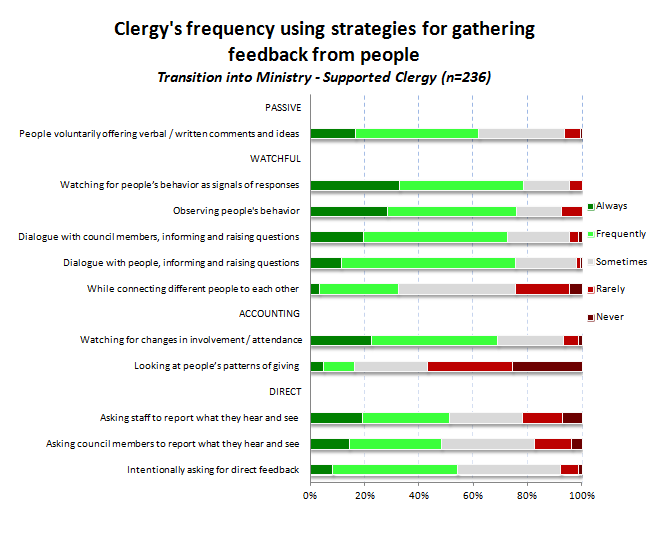One of the weak points in any communication loop is feedback. Leaders may believe their message has “gotten out there,” but how do they check to see whether or not the ideas or messages they communicated have actually been received, and how they have been received?
When asked about feedback, one pastor who participated in the Clergy Into Action Study commented, “I do get feedback—both positive and negative. About sermons, and about the newsletter, too. And most of that has been positive…. Of course, people are more ready to give positive criticism than negative criticism.…”
Feedback is the means by which leaders know if and how their communications and change efforts are having the intended—or unintended—results. How did people really respond to that challenging sermon? How are the church council members working with the directives they agreed to set? How are people responding to the new church initiative that’s about to be launched?
As change is introduced in a congregation and the surrounding community, a pastor needs to listen for its emotional and spiritual impact. However, obtaining honest, thorough feedback can be challenging for clergy not trained in how to seek it, and most congregations do not have procedures for communication feedback in place.
Clergy use a range of strategies and processes to elicit or receive feedback, from more passive approaches to more active and engaged approaches. There are four basic approaches:
- Passive (waiting to receive direct feedback voluntarily offered by people). This is the suggestion box approach, or the stance of “My door is always open.”
- Watchful (gauging people’s interest and response in the midst of natural interactions and events, without directly asking). This is the “antennae up” approach, listening for hints in people’s conversation and watching for signals in their behavior about how they are responding to something communicated.
- Accounting (assessing people’s responses by watching changes in observable actions, like attendance, volunteerism, and monetary giving). This is the tally sheet approach, reading “the books” for patterns and changes.
- Direct (intentionally asking for feedback). This is the “face-to-face” approach, asking direct questions of community members. It also involves surrogates—fellow staff members and lay leaders—asking directly for feedback on clergy’s behalf.
Each of these feedback approaches has its own benefits—and serious limitations as well. When any of these four approaches is neglected or avoided, church leaders fail to get a complete picture of how people are responding to communications and change efforts.
In our surveys, we asked clergy who had been ordained 1–12 years about their use of different approaches to gathering feedback. The charts above show their response patterns, grouped according to the four basic approaches to feedback.
Newer clergy seem to prefer relying on the “watchful” approach and were less likely to rely on “accounting” or “direct” approaches.
To get a sense of people’s responses to communication and efforts in ministry, recently ordained pastors and priests most frequently rely on non-verbal cues. Nearly 80% of newer clergy reported frequently taking this almost “naturalistic” approach, observing people’s interactions.
Similarly, over 70% of recently ordained clergy frequently seek to discern feedback in the process of back-and-forth dialogue with community leaders and members, as they see how others raise questions and respond to information offered. In a more passive manner, two-thirds of newer clergy often receive feedback from people who voluntarily offer written or verbal feedback (sought or unsought).
Recently ordained clergy are noticeably less likely to ask intentionally for direct feedback with any frequency (54%). They are also less likely to ask staff or church council members frequently to report what they hear and see as feedback (about 50%). They are quite unlikely to look at people’s patterns of monetary giving with any frequency (18%). And a more nuanced way of getting a “read” of people’s feedback in the midst of helping connect people to each other seems elusive for most clergy who were recently ordained.
Overall, post-seminary Transition into Ministry (TiM) development programs did not result in a different pattern in how clergy seek feedback. TiM clergy do not differ notably from other newer clergy who did not have additional post-seminary training programs—except for a slightly higher percentage of TiM clergy who have learned to observe people’s behavior consistently for signs of response, and who engage consistently in dialogue with church council members. In contrast, non-TiM clergy more frequently take a consistent passively receptive stance, looking for people voluntarily to offer feedback, comments, and ideas.
For Your Consideration
- How are clergy being trained to seek and discern feedback—in interactive (“watchful”) and direct ways as well as in passive and accounting ways?
Only 1 of every 6 recently ordained pastors and priests indicate having no feedback systems or strategies in use. Similarly, only 1 of 6 recently ordained clergy report that people are often unresponsive, negative, or highly critical. Clergy respond similarly to these two questions—pastors and priests who report having no feedback systems or strategies are also most likely to attribute the problem to people in their faith communities.
Related Articles
- Research: The Arts of Communication in Religious Leadership
- Research: How Do Clergy Communicate Core Ideas?
- Story: Managing Church Communications, Digital and Personal




